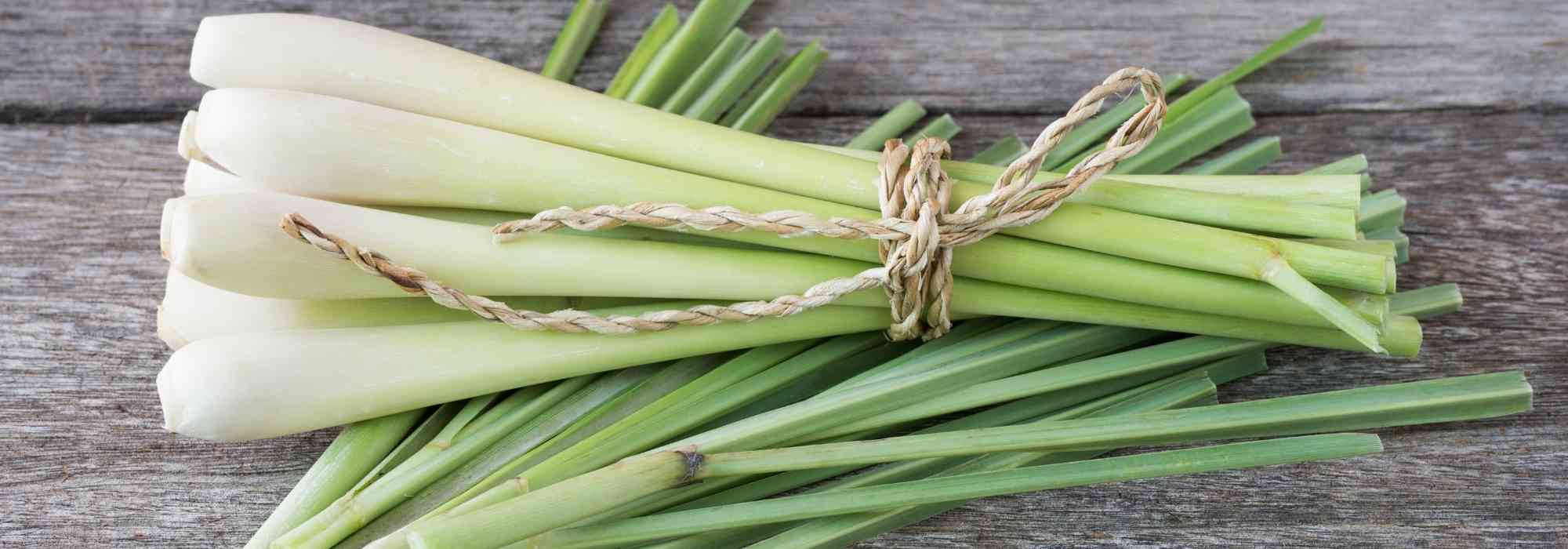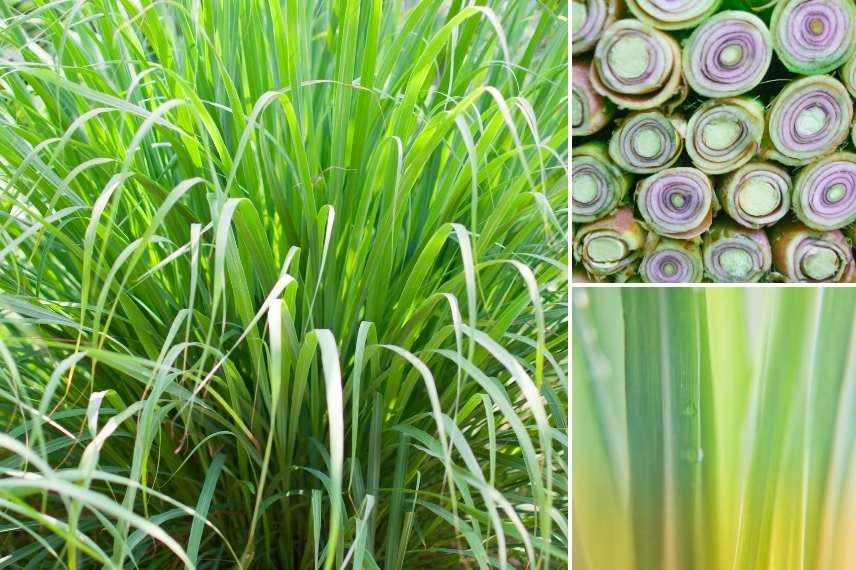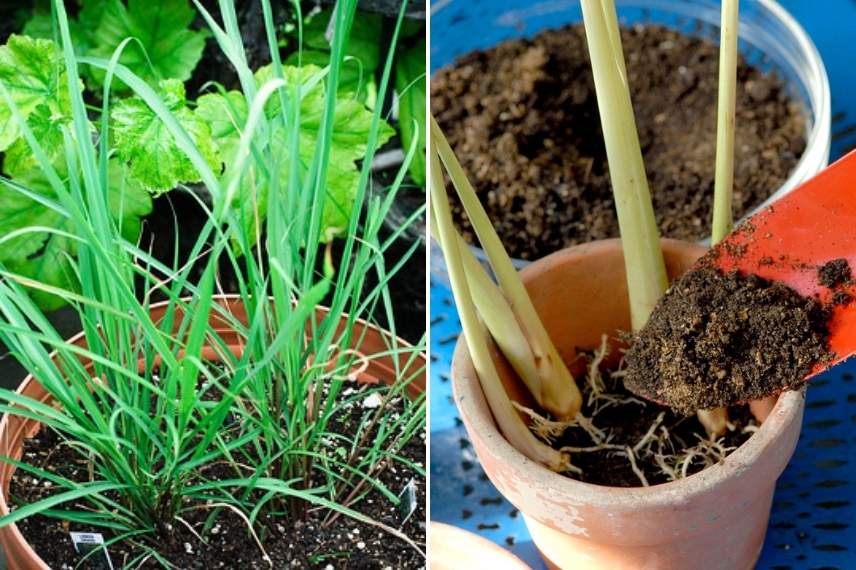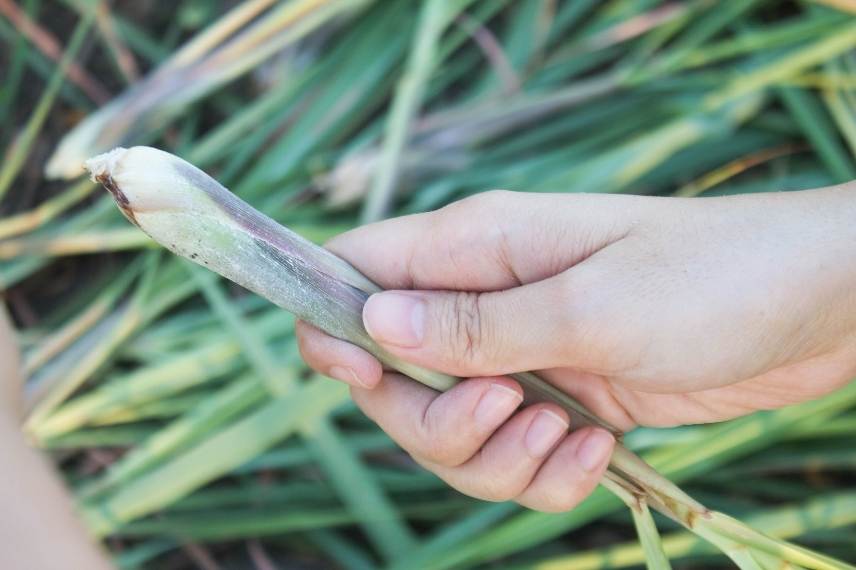
Growing lemongrass in a pot
to enjoy it all year round
Contents
Aromatic plant, Cymbopogon citratus by its Latin name, also called Madagascan lemongrass or Indian verbena, is unlike lemon verbena well known in our latitudes, a perennial grass of tropical origin. It forms a dense clump of evergreen linear, ribbon-like leaves, strongly veined, bluish green in colour, reaching up to 1 m in height. Sterile plant, it does not produce flowers.
When crushed, lemongrass leaves are highly aromatic, but it is the base, in the form of a swollen bulb, that is mainly used in cooking, for many Asian dishes: its tangy, lemony flavour is used as a condiment in curries, with fish, in soups or with vegetables; it is also excellent used fresh or dried as an infusion, as it has digestive properties and is very refreshing. Cymbopogon citratus is also rich in vitamin C and has antibacterial and diuretic properties!
Frost-tender, its hardiness (it copes poorly with temperatures below 8°C) means we mainly grow it in a pot, so it can be overwintered without problems, except on Mediterranean coastline where it acclimatises quite well.
To give it the best chance when planted in a pot, here are some recommendations that should help you to grow and keep it for a long time, for the pleasure of your taste buds!

Madagascan lemongrass : plant, stems and leaves
Also discover our complete guide to Lemongrass
Where and when to plant?
Lemongrass’s sensitivity to cold and Indian origins mean it favours a warm, full-sun position. It needs at least 10°C to develop. Around the Mediterranean, you can plant it outdoors in a sheltered, south-facing spot.
Elsewhere, you should therefore pot it so you can bring it under a greenhouse or into a frost-free, well-lit shelter as soon as temperatures fall in autumn. Place it on your terrace, balcony, in the garden or in the vegetable patch if you prefer, provided the pot is south-facing and in full sun.
Its strong aromatic scent repels mosquitoes. Don’t hesitate to position it around the house and on the terrace to enjoy summer evenings! If you choose to plant it in the vegetable patch, situate it close to tomatoes, melons or peppers: lemongrass is thought to deter the leaf miner.
Plant lemongrass in spring, ideally in May after frosts, up to September to ensure good establishment. At this time of year, place it outdoors directly provided temperatures are above 10°C.
How to plant lemongrass?
Lemongrass prefers rich, fresh soils and a well-drained substrate. Prepare a substrate compound of one-third sand to your mix of garden soil and potting compost.
Provide a pot with a minimum diameter of 30 cm, in which place a bed of clay pebbles or gravel. Install your young plant or divided clumps if you are propagating from a mother plant.
As with any container planting, your lemongrass will need regular fertiliser applications. About one month after planting, help it by adding a natural fertiliser. Thereafter, an annual feed will be sufficient. Water generously but do not allow water to stand in a saucer if you have one.
Plan to repot as soon as you observe that roots are cramped in the pot (they will start to protrude slightly), every 2 years or so.

Lemongrass in pot and repotting
Of rapid growth in its natural habitat, it will not reach the height it attains in tropical countries, but it easily flourishes up to 70 to 80 cm in our gardens.
Care and propagation
Very easy to care for, citronella does not really require particular attention. Water it generously in summer as it prefers a fresh substrate and regular watering during its growth. Surface soil must always remain moist. Reduce watering progressively in October until overwintering. Do not cut back citronella leaves in late autumn when placing it in a greenhouse or in a bright, airy shelter; this operation is carried out only in open ground. You can lightly mulch with leaves between stems if your shelter is not a greenhouse receiving sun during winter months.
Like any plant in a pot, it needs fertiliser to properly feed substrate and roots. Carry out this application once a year, in spring, using a liquid feed. Finally, remove any leaves that may have dried out, and eliminate oldest stems.
Using the plant for recipes or infusions by harvesting leaves gradually thins it out. You can therefore propagate it by dividing clumps in May, carefully taking shoots that have fine rootlets at periphery of pot. Soak fleshy part of bulbs in a little water until fine roots appear. Then plant each young plant in a small 9-10 cm diameter pot, and place them outside in partial shade while temperatures remain above 10°C.
Read also
Balcony vegetable gardenHarvesting
You can harvest stems when lemongrass has produced enough swollen bulbs at its base, after 3–4 years’ cultivation, when plant has abundant foliage.
Pick young leaves as needed, cutting them at the base to include the bulb, which is most aromatic and very tender. Avoid harvesting stems for consumption as winter approaches: the more foliage you leave, the better plant will cope with winter. Use fresh stems, much more aromatic than dried.

Cut lemongrass at base of swollen bulb
Uses
Long leaves are used only as an infusion, fresh or hot. It is the swollen base of the stem that is used to prepare excellent Vietnamese and Thai dishes, and dishes from other Southeast Asian countries.
Learn how to make homemade lemongrass oil for cooking with our tutorial. You can also use lemongrass essential oil, excellent as a mosquito repellent.

Lemongrass is delicious in Thai soup or as an infusion
- Subscribe!
- Contents
































Comments